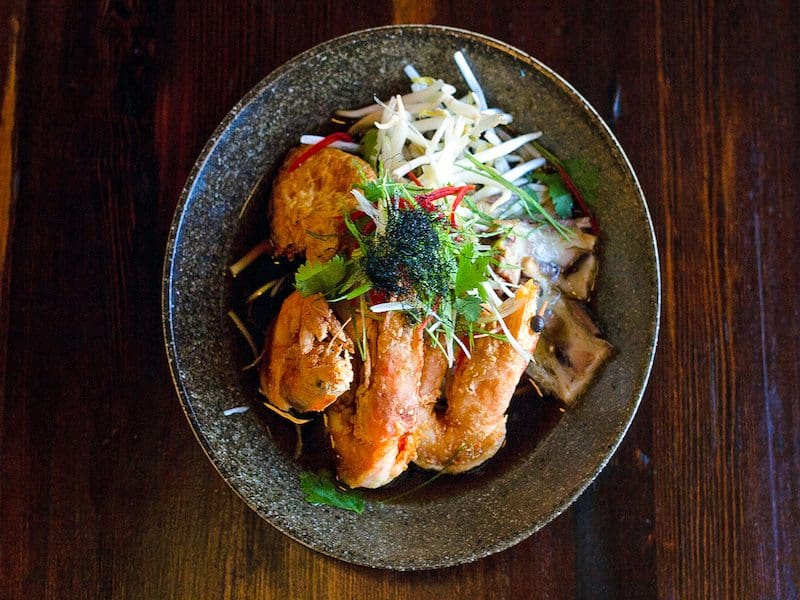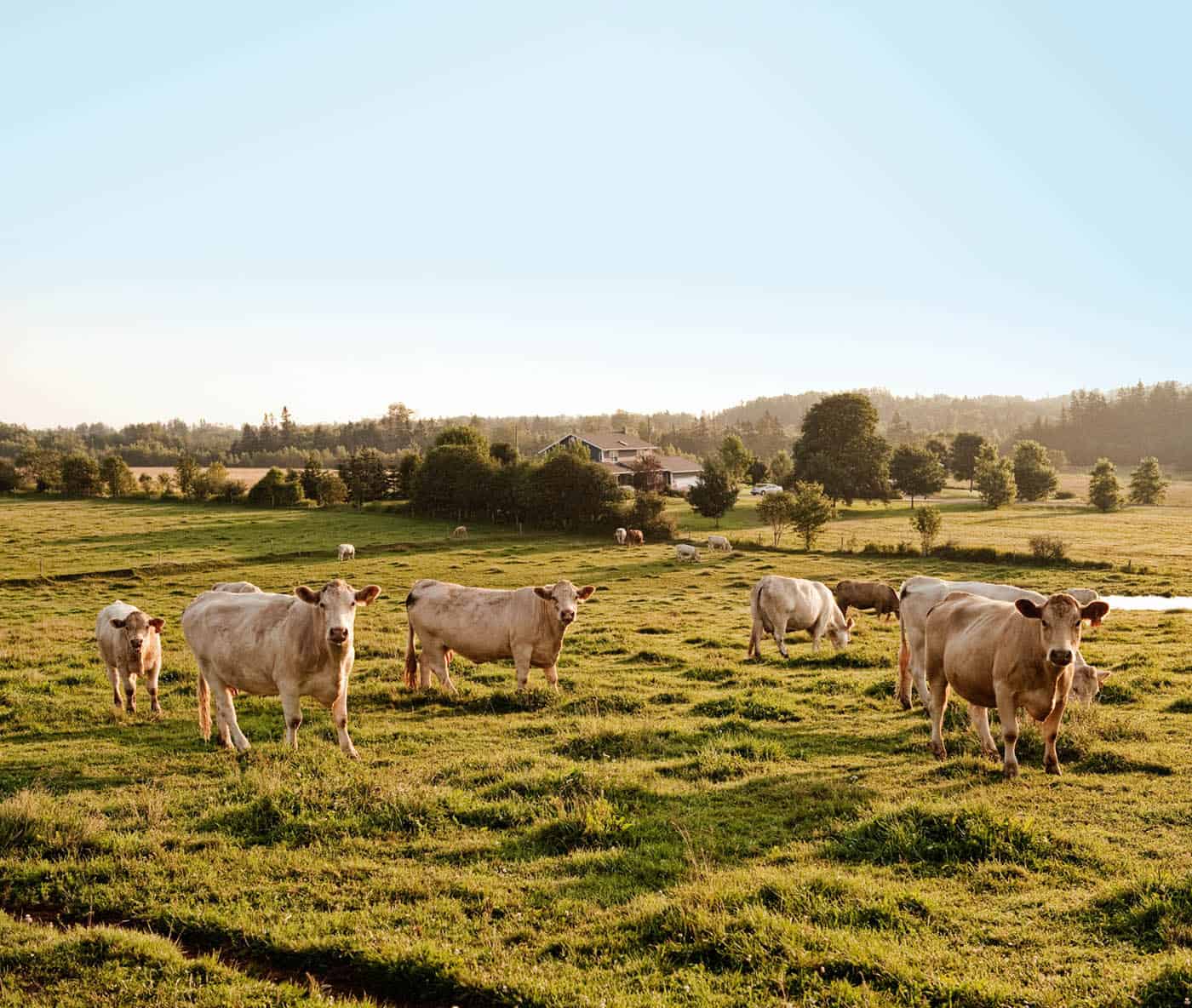
After a big Chinese New Year, noodle soup is something we eat the next day in the morning.
After a week of celebration, you’re going to need some broth and noodles at some point. You’re going to be hungover from the night before and you’re going to have lots of leftovers. Noodle soup is the answer. My dad would make a variation of this dish. He’s Chinese, born in Calcutta, and my mom is South African Chinese of Hakka descent.
I put a lot of the symbols of Chinese New Year in here. The egg is about new beginnings, and noodles and rice mean longevity and prosperity. At Chinese New Year you want to spend money. It’s a karma thing. So the truffles are my symbol of prosperity, giving your guests the best in order to receive the best in the new year. Seaweed—fat choy—is also important at the New Year, and there’s always a dish with seaweed and mushrooms.
When I make any soup noodles, I’m usually just putting in whatever’s lying around from the night before. That’s what soup noodles are all about. And they always mean you’re hungover.
—N.L.
Nick Liu’s Chinese New Year Soup
Ingredients
Master Stock
• 1 L (1 quart) high-smoking point oil (re ned peanut or canola)
• 1 pork hock
• 8 garlic cloves, chopped
• 4 cm (11⁄2 inch) piece of ginger, peeled
chopped
• 4 coriander roots, sliced
• 2 red chilies, sliced
• 15 white peppercorns
• 125 ml (1⁄2 cup) Shaoxing (Chinese cooking
wine)
• 125 ml (1⁄2 cup) sweet soy sauce (preferably
ABC)
• 250 ml (1 cup) oyster sauce
• 1 stick cassia bark (or cinnamon bark)
• 3 star anise
• 250 ml (1 cup) soy sauce
• 2 L (2 quarts) chicken stock
Garnish
• 2 baby cucumbers, sliced thin
• 2 scallions, julienned
• 2 red chillies, deseeded and julienned
• 1⁄4 bunch coriander, leaves only
• 1 tbsp rice wine vinegar
• 50 ml (1⁄4 cup) fat choy (black seaweed),
reconstituted in warm water
• 8 large shrimp, peeled and deveined
• 1 tbsp sh sauce
• 50 ml (1⁄4 cup) corn starch
• Salt
• 4 eggs
• 50 ml (1⁄4 cup) sesame oil
• Pepper
• Chinese noodles, best quality
• Black truffle, to taste
Method
Transfer oil to a deep heavy-bottomed saucepan or wok large enough to accommodate the hock—but fill no more than halfway. Heat oil on high to 200°C (400°F). Carefully add the hock and fry until bronzed on all sides—about 5 minutes. Remove to drain on paper towels. Reserve oil.
Combine garlic, ginger, coriander, chili and peppercorns in a mortar, and with a pestle, pound into a paste. Place a Dutch oven over medium heat, add 1 tbsp of the frying oil, and then cook the paste, frequently stirring, until the aroma becomes nutty—about 2 minutes. Raise heat and deglaze with the wine. When it has reduced to syrup, add the oyster sauce, cassia, star anise, soy sauce and stock. Bring to a boil, and skim scum and oil that rises to the surface. Lower heat, and simmer for 10 minutes skimming as needed. Add the pork, cover pot, and simmer until meat is tender and nearly falling off the bone—2-3 hours.
With a slotted spoon remove pork to a platter, cover with plastic wrap, and set aside at room temperature. Strain stock through a fine-mesh sieve into a clean saucepan and reserve. When the hock is cool enough to handle, twist and remove the bone and discard. Transfer meat to a Tupperware container. Place another smaller Tupperware container on top of the first, then add a weight, and transfer to the refrigerator until the meat sets—1 hour minimum.
In a bowl combine cucumber, scallion, chili, coriander and vinegar. Toss well. Season with salt and set aside. Drain the fat choy and pat dry with paper towels. Use a slotted spoon to carefully lower into the frying oil (it will spit). Fry until crisp—about 30 seconds—then transfer to paper towels to drain. Remove one slice of pressed pork hock, shred, and deep-fry until crisp—about 5 minutes. With a slotted spoon remove to drain on paper towels.
In a bowl, combine shrimp and shrimp sauce, and toss well. Transfer cornstarch to another bowl. Add shrimp, toss to coat, shake off excess corn starch, and lower them carefully into the frying oil. Cook until bronzed and crisp—about 1 minute. Then with a slotted spoon, remove them to paper towels to drain. Season with salt immediately on both sides.
Heat a small non-stick skillet on high, then add sesame oil. When it begins to shimmer, crack an egg directly into the pan. As the albumen begins to set and the edges brown, use a spatula to fold the edges inwards, over the yolk. Then, carefully flip the egg. Cook until golden all over—about 1 minute on each side. Then remove egg to paper towels to drain. Repeat three more times.
To finish bring the broth to a simmer. Cook noodles as directed on the package. Remove pressed pork from its plastic container and slice 0.5 cm (1⁄4 inch) thick. Distribute noodles between four warm bowls, mounding them at centre. In each bowl at 12 o’clock arrange 5 slices of pork, at 4 o’clock the crisp egg, and at 8 o’clock, 2 crispy shrimp. Mound the cucumber salad on top of the noodles. Ladle the broth into the bowls over the pork slices (and not over the crisp egg or shrimp). Sprinkle the crispy pork and fat choy over each portion, and finish with truffle shavings.



